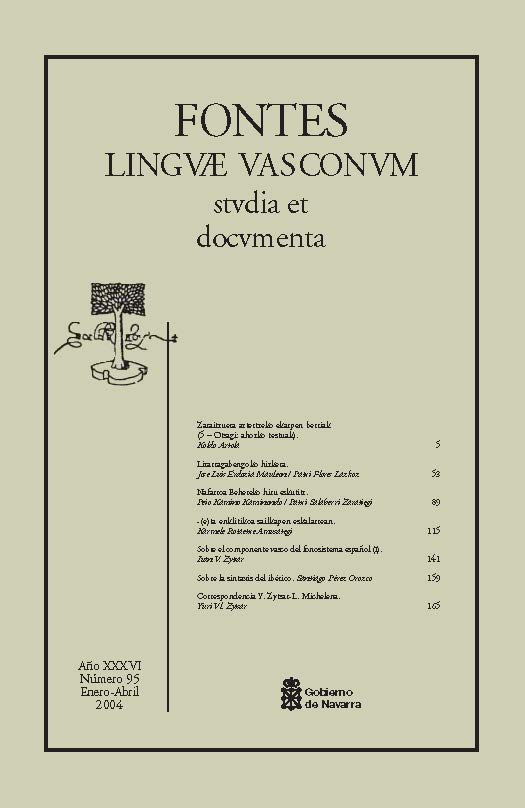-(e)ta enklitikoa sailkapen eskalarrean
Abstract
The current article proposes a classification of the Basque unit known as “-(E)TA enklitikoa” as part of a continuous axis on which it would occupy an intermediate position between the conjunctions of coordination and subordination. In order to justify this hypothesis, the unit in question is analysed through its constituent features, both formal and semantic. Evidence such as its phonic behaviour and distribution go to show that it is not an element of coordination, despite its similarity in terms of spelling with the coordinative conjunction ETA. Other evidence of form, however, do not permit a classification of the enclitic -(E)TA among the elements of subordination, although its meaning may express causal subordination, albeit peripherally. For these reasons, it is proposed that we are dealing with a [-coordinative], [-subordinative] element and a classification of scale is defended, something becoming more and more common in modern, theoretical linguistics. Its mobility is highlighted as, unlike subordinative elements, it can attach itself to any part of the verbal cluster in the clause. Also stressed is its peripheral nature in the indication of cause: the phrase that it introduces remains relatively independent from the main clause, bringing the idea of separability to mind.
##about.statistics##
References
AGIRRE BEREZIBAR, J. M. (1991) Euskal Gramática deskriptiboa, Bilbo: Bizkaiko Foru Aldundia, Labayru Ikastegia. (tomo 2).
ALTUBE'tar Seber (1929) Erderismos, Monogr. Euskera, X Urtea, I-IV Zenbakia, Bilbo: Euskaltzaindia.
ARTIAGOITIA, X., P. GOENAGA, J. LAKARRA (arg/eds.) (2002) Erramu Boneta: Festschrift for Rudolf P.G. de Rijk, Bilbo: Universidad del País Vasco/Euskal Herriko Unibertsitatea.
ATXAGA, B. (1984) Obabakoak, Donostia: Erein.
AZKUE, R. M. de (1933[1969]) Morfología Vasca (3 tomos), Bilbao: La Gran Enciclopedia Vasca.
BOSQUE, I., DEMONTE, V. (dir.) (2000) Gramática descriptiva de la lengua española, 3 tomos, Madrid: RAE.
CULICOVER, Peter W., Ray JACKENDOFF (1997) "Semantic Subordination despite Syntactic Coordination", Linguistic Inquiry Vol. 28, Number 2, Spring 1997.
EUSKALTZAINDIA (1984) OEH -testo Corpusa- CD Rom, Bilbo.
EUSKALTZAINDIA(1994a) Euskal Gramatika Lehen Urratsak, EGLU IV, Bilbo.
EUSKALTZAINDIA(1994b) "Erartopenaz", in Euskera, 39, 1994-3: 1079.
FEUILLET J. (1998) (ed) Actance et Valence dans les langues de l'Europe, (Programme EUROTYP/EUROTYPE), Berlin, New York: Mouton de Gruyter. https://doi.org/10.1515/9783110804485
GALÁN RODRÍGUEZ, C. (2000) "La subordinación causal y final", in Bosque, I., Demonte V. (2000), tomo III, 56: 3597-3642.
HOPPER Paul J., THOMPSON, Sandra (1980) "Transitivity in Grammar and Discourse", Language, Vol. 56, Number 2: 251-299. https://doi.org/10.1353/lan.1980.0017
MORENO CABRERA, J. C. (2002) "El motor de la economía lingüística: de la ley del mínimo esfuerzo al principio de la automatización retroactiva", Revista de la Sociedad Española de Lingüística, 32-1, enero-junio 2002: 1-31.
ROTAETXE, K. (1978a) Estudio estructural del euskara de Ondárroa, Durango: L. Zugaza.
ROTAETXE, K.(1987b) "L'accent basque: Observations et Hypothèses", La Linguistique, Revue Internationale/International Review, 1978, 2: 155-177.
ROTAETXE, K.(1981) "Euskal Prosodiaz", Euskera, XXVI, 2.ald., 1981-1: 380-396.
ROTAETXE, K.(1998) "Constructions triactancielles et Datif", in Feuillet, J. (ed) (1998): 390-457. https://doi.org/10.1515/9783110804485.391
ROTAETXE, K.(2002) "Datibo-Markazioa", in X. ARTIAGOITIA, P. GOENAGA, J. LAKARRA (arg./eds.): 570-583.
ZUBIRI I., ZUBIRI E. (1991) Euskal Gramática Osoa, Bilbo: Didaktiker
Copyright (c) 2004 Karmele Rotaetxe Amusategi

This work is licensed under a Creative Commons Attribution-NonCommercial 4.0 International License.







